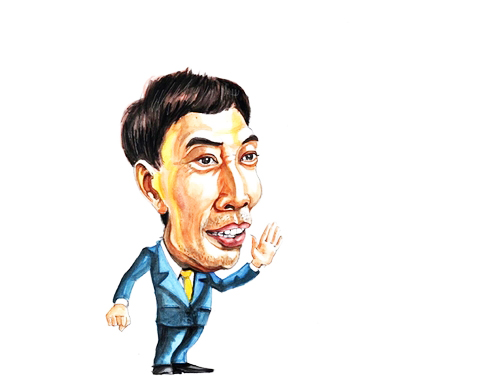 Economy
Economy

As the trade-off between business efficiency and “going green” is diminishing, Việt Nam’s economy and enterprises are accelerating towards green and sustainable growth in line with mainstream global trends.

|
| Võ Trí Thành |
*Võ Trí Thành
As the trade-off between business efficiency and “going green” is diminishing, Việt Nam’s economy and enterprises are accelerating towards green and sustainable growth in line with mainstream global trends.
The world is witnessing mega-trends in geo-politics, globalisation and liberalisation, climate change and innovation, with different scenarios. Development issues in recent years are perceived as not completely new but deeper with qualitative changes, including shifts from economic growth to sustainable and inclusive development, from “brown economy” to “green economy”, from “linear economy” to “circular economy” and from “real economy” to “digital economy”.
Despite challenges in both domestic and international markets, State leaders have demonstrated their strong political commitments towards green growth, agreeing that the transition to an environmentally friendly economy has created enormous potential to achieve sustainable development.
Green growth is central to achieving the 17 United Nations Sustainable Development Goals (SDGs) by 2030. It is also the focus of national development policies of many countries around the world. Many governments have implemented or endorsed a Green Growth Strategy which improves the legal and policy framework together, such as the EU, South Korea, Japan and Việt Nam.
In the most recent action, 136 countries – which are responsible for 88 per cent of greenhouse gas emission and 90 per cent of global GDP – committed to achieve “net zero emissions” by the middle of the 21st century at the 26th United Nations Climate Change Conference of the Parties (COP26) held in Glasgow, Scotland (the UK) in November 2021.
Green growth is also clearly stated in the ASEAN Community vision 2025: “ASEAN recognises the importance of sustainable economic development as an integral part of the region’s growth strategy… ASEAN would actively promote green development by developing a sustainable growth agenda that promotes the use of clean energy and related technologies, including renewable energy through green technology, as well as enhances sustainable consumption and production, and including it in national development plans.”
However, this trend not only comes from political commitment of governments but also market pressure.
Consumers are pursuing green consumerism and green lifestyle in which consumers demand green and safe products. The rising awareness of environmental protection is penetrating deeply into consumer consciousness which forces manufacturers to green both their products and manufacturing processes, as well as take into account their social responsibility.
New business models and investment sectors including green economy, circular economy, smart city and creative economy are capturing enterprises’ attention.
The implementation of international cooperation and commitments, especially high-quality free trade agreements (FTAs) such as the Comprehensive and Progressive Agreement for Trans-Pacific Partnership (CPTPP) and EU-Vietnam FTA (EVFTA), accompanying cheaper tools to transition to green models, are also pushing enterprises to think green and go green.
Việt Nam is ready
From the 1900s, Việt Nam implemented strategies and policies on poverty reduction, human development and sustainable development. In 2004, it issued the Strategic Orientation on Sustainable Development (Việt Nam's Agenda 21). Since then, various strategies, plans and regulations were issued and updated with a view to balance the economic interest and the negative externality on the environment.
In recent years, the country’s commitment to SDGs has been jointly monitored together with Việt Nam’s Sustainable Development Indicators (including SDGs targets and 115 specific goals stipulated in Decision 622/2017/QĐ-TTg).
In 2020, it passed the Law on Environmental Protection in which for the first time, the definition of circular economy (CE) is stated and various policies and regulations on CE have been issued or drafted since 2021. And in early June this year, Deputy Prime Minister Lê Minh Khái signed Decision No. 687/QĐ-TTg approving a scheme developing the circular economy which is expected to contribute to cementing the goal of reducing greenhouse gas emissions intensity within GDP by at least 15 per cent by 2030 compared to 2014, towards the goal of net zero emissions by 2050.
Vietnamese Government also adopted the Green Growth Strategy 2021-30, with a vision to 2050 in October 2021.
Immediately after COP26, Việt Nam displayed its strong determination to implement its announced commitments. It established the National Steering Committee, chaired by Prime Minister Phạm Minh Chính to discuss and undertake the commitments in December 2021. It is currently completing the relevant legal framework to fulfil these commitments in an urgent manner, including introducing the Action Programme expected this year.
On the business side, there have been certain movements in reality.
In agriculture, farmers are shifting from traditional farming model VAC (garden-pond-barn) to new models to reduce the adverse impact on the environment and make use of raw materials more efficiently such as VAC+biogas, VAC+forest and VAC+raising shrimp or planting rice.
In industrial production, both authorities and provinces have pledged to promote eco-friendly industrial parks (IPs), especially the Nam Cầu Kiền eco-IP in Hải Phòng City built in 2008 according to Japanese standards, which is a private initiative in which production communities have a symbiotic relationship with efficiency in environmental and natural resources management.
Businesses are also investing more heavily in green business models such as “green circle” in dairy farms of Vinamilk or TH Milk. More and more businesses are also developing according to the criteria of the Corporate Sustainable Development Index (CSI) launched by the Vietnam Chamber of Commerce and Industry (VCCI) and the Vietnam Business Council for Sustainable Development (VBCSD) since 2016.
The CSI programme qualifies and honours responsible businesses in three aspects including economy, social responsibility and environment. According to VCCI, CSI-certified businesses are proved to be more resilient, even during the COVID-19 pandemic. Sustainable development is considered a “green passport” for enterprises to develop and integrate deeply into the world.
From the capital side, many financial institutions are taking bold steps to finance and facilitate green and eco-friendly loan packages as an essential part of their sustainable investment and net-zero pledges.
According to the State Bank of Việt Nam (SBV), more than 31 financial institutions are involved in green credit, with total credit of VNĐ290 trillion (US$12.5 billion) in 2020, mainly in fields of green agriculture and renewable energy.
Việt Nam has paid the price for growth (resource degradation and environmental pollution, especially in big cities). The country is also one of the most affected by climate change. However, the transition to green growth is a challenging process.
Việt Nam’s action plan of the green growth strategy 2011-20 recorded only three out of 12 goals achieved with low spillover impact.
The reasons include weak awareness of green development, institutional reform, education and media campaigns at that time, and challenges from "bottom up" (competitiveness, management under new business models, technology, investment) to “top down” (infrastructure, human resources, creativity promotion). The conversion cost is not small.
In addition, national efforts and international cooperation are essential. Prime Minister Phạm Minh Chính said in a meeting in May this year: "To achieve the national development goals, Việt Nam cannot go alone. If you want to go far, you must have friends."
In the world with many uncertainties and risks, enterprises need to learn how to manage risks and shocks from geopolitical tensions, supply of input materials, financial-monetary instability and natural disasters.
In a world which underscores connection and technological leaps, learning how to strengthen competitiveness through connecting markets, partners in global value chains and global standards is necessary. Learning to be continuously creative and successfully transform digitally (products, skills, business model, management) is key to success.
Despite challenges, with the strong political commitment and practical actions from the Governenment to enterprises, Việt Nam is expected to achieve their set goals in developing the green economy in the future.
*Võ Trí Thành is a former vice-president of the Central Institute for Economic Management (CIEM) and a member of the National Financial and Monetary Policy Advisory Council. The holder of a doctorate in economics from the Australian National University, Thanh mainly undertakes research and provides consultation on issues related to macroeconomic policies, trade liberalisation and international economic integration. Other areas of interest include institutional reforms and financial systems.




